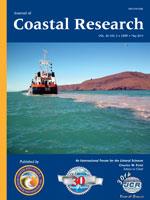Gontz, A.M.; Moss, P.T., and Wagenknecht, E.K., 2014. Stratigraphic architecture of a regressive strand plain, Flinders Beach, North Stradbroke Island, Queensland, Australia.
Regressive beaches are commonly composed of extensive and complex beach ridge systems. The physical and stratigraphic relationships of the beach ridges can help decipher the interactions between sea-level changes, variation in storm periodicity and intensity, changes in current directions, and alterations in sediment sources. Similar systems have been identified on the SE coast of Queensland and the spatial and temporal relationships between the various depositional environments are poorly understood. A small-strand plain system was identified on the NE coast of North Stradbroke Island, Queensland, Australia, and targeted for study with ground-penetrating radar (GPR). A series of GPR transects were acquired to elucidate the subsurface architecture of the system and to establish a geologic and geomorphic framework for the system through the application of stratigraphic analysis and decipher the spatial relationship. The GPR survey was concentrated in the center of the system and acquired approximately 3 km of 250-MHz data. The survey shows the stratigraphic relationship between modern sand dunes, beach ridge sequences, wetlands, and the much older Pleistocene sand dunes and identifies a potential Holocene storm record. We established a stratigraphic link between environments and propose a model driven by sea-level change, which proposes beach-ridge development during the early/mid-Holocene regression.





